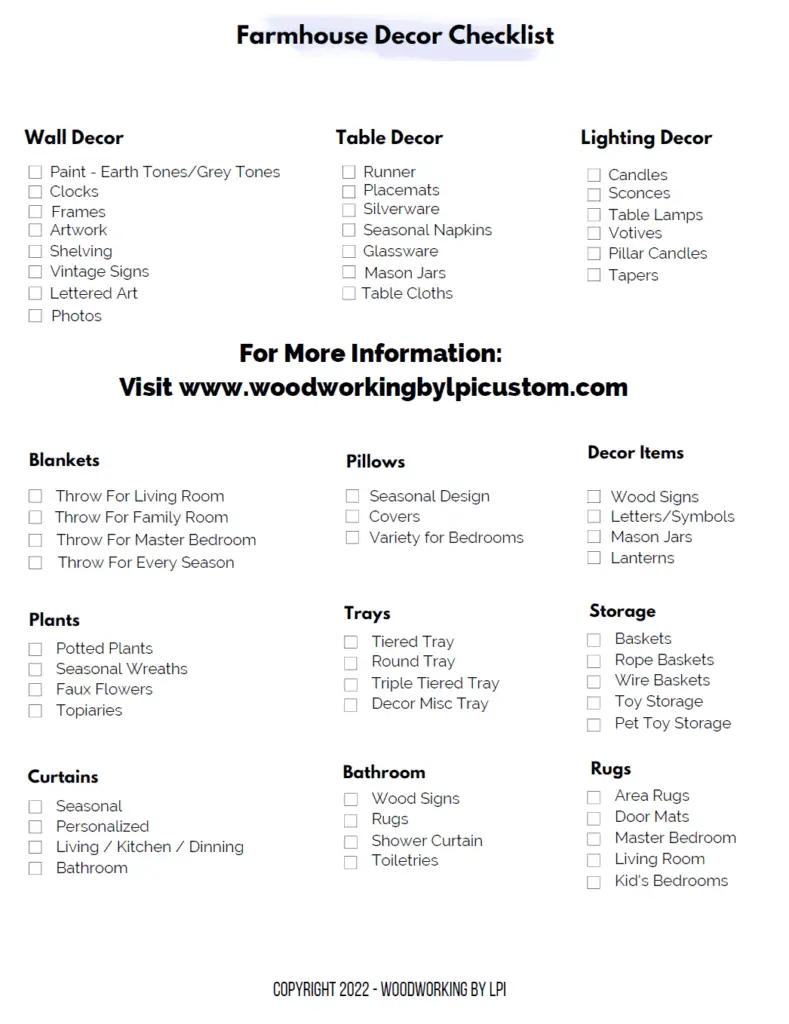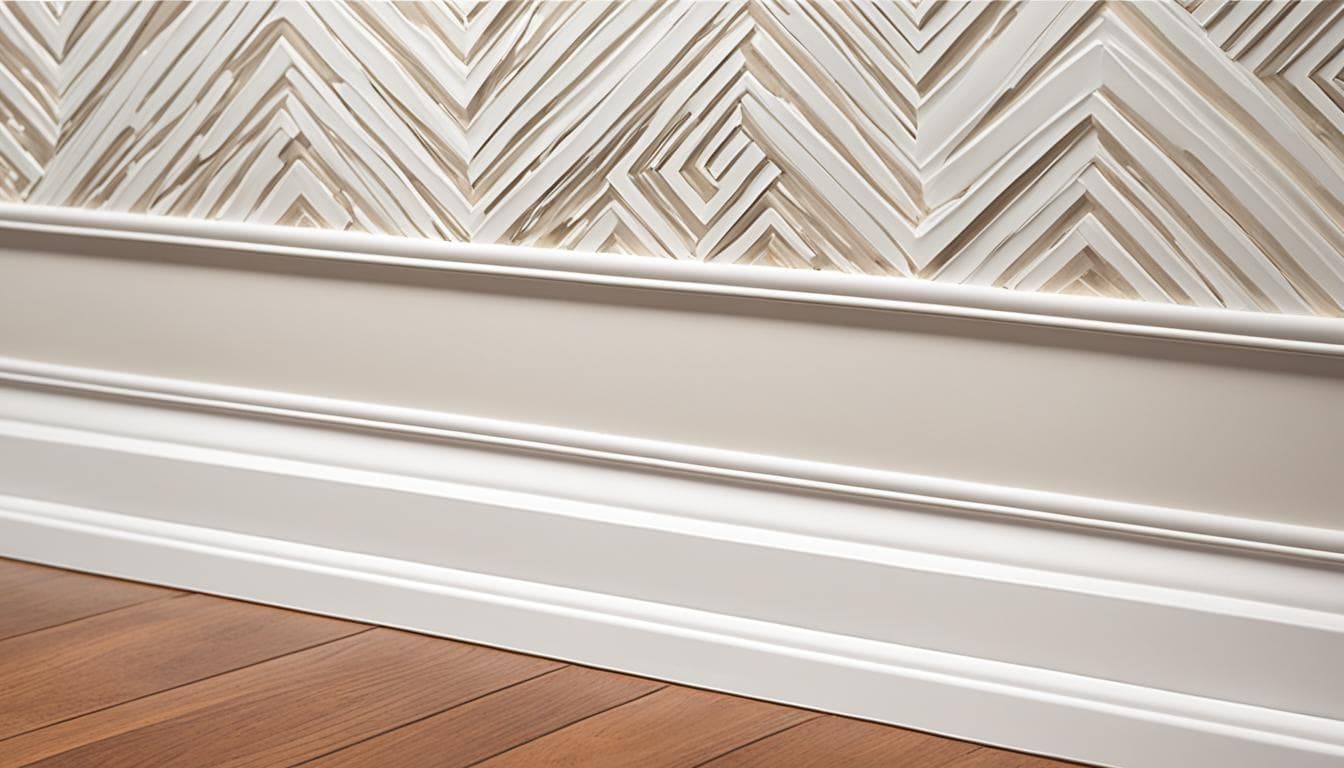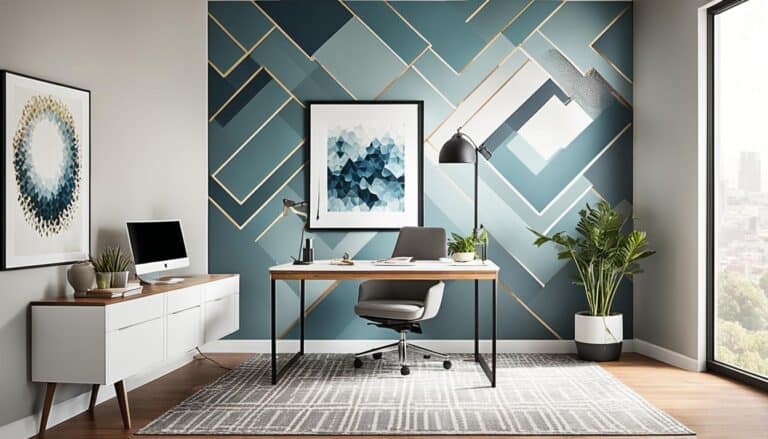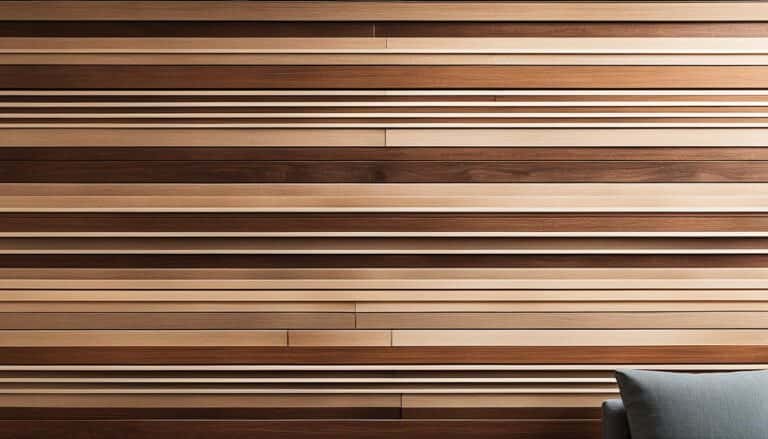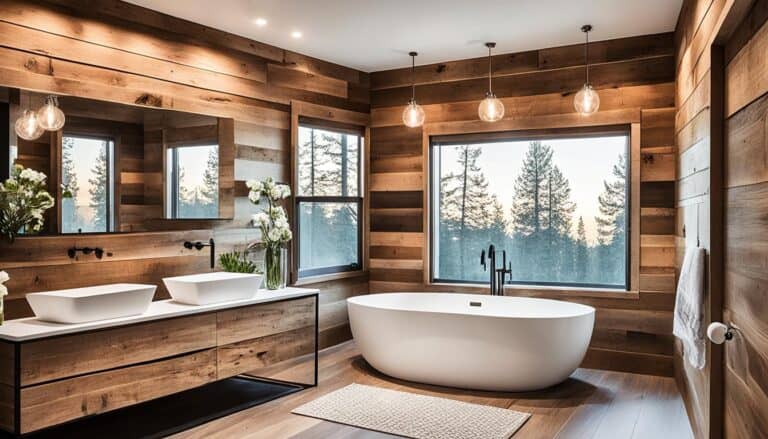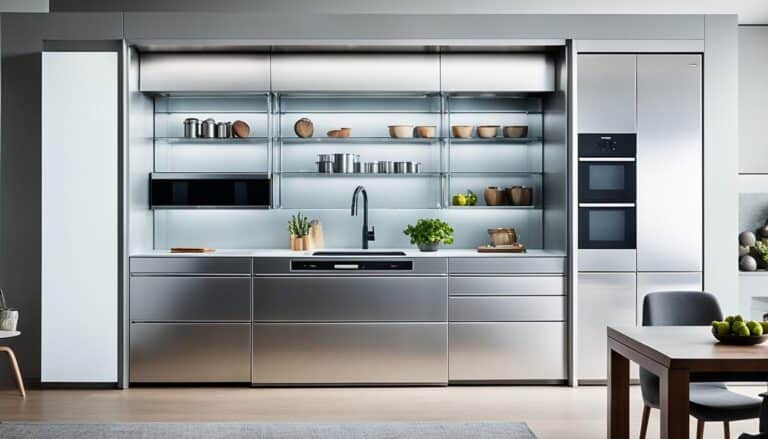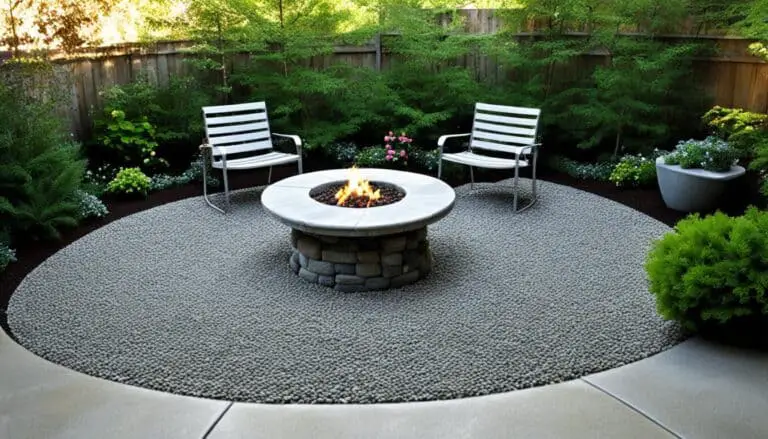Are you looking to transform your home’s interior with a touch of modern elegance? Discover the latest baseboard trends and innovative designs that can completely revamp the look and feel of your space. From contemporary baseboard ideas to stylish trim profiles, explore the up-to-date concepts that can elevate your home’s aesthetic.
Baseboards are no longer just functional elements that cover gaps between walls and floors. They have evolved into chic molding details that add visual depth and style to any room. By incorporating modern baseboard styles, you can create a cohesive and sophisticated atmosphere that complements your decor.
Key Takeaways:
- Explore the latest modern baseboard trends to enhance your home’s interior.
- Discover innovative designs and stylish options that can elevate your space.
- Learn how baseboards can add visual depth and complement your decor.
- Understand the importance of selecting the right materials for your baseboards.
- Find inspiration for incorporating baseboard molding into your home design.
The Importance of Baseboards in Home Design
Baseboards play a crucial role in home design, serving as more than just a minor detail. They provide visual depth to rooms, protect fragile finishes, and cover gaps between walls and floors caused by natural shrinking and expansion. Whether you prefer a minimalist look or value both functionality and aesthetics, baseboards are an essential element in creating a polished and cohesive space.
One of the key benefits of baseboards is their ability to add visual depth to your rooms. By creating a clear boundary between the walls and floors, baseboards contribute to a layered and finished look. They create a sense of structure and provide a visual anchor for the overall design of the room. Additionally, the strategic placement of baseboards can enhance the perception of space, making rooms appear larger and more inviting.
Baseboards also serve as a protective barrier for fragile finishes. They act as a buffer, preventing accidental damage to the lower portion of your walls from furniture, vacuum cleaners, or foot traffic. This helps to maintain the integrity and longevity of your walls, ensuring that they remain in pristine condition over time.
Another important function of baseboards is to cover gaps between walls and floors. These gaps are naturally formed due to the expansion and contraction of building materials in response to changes in temperature and humidity. Baseboards effectively camouflage these gaps, creating a seamless and cohesive transition between the walls and the floor. They prevent debris, dust, and insects from collecting in these spaces, resulting in a cleaner and more hygienic environment.
“Baseboards are an essential element in home design, adding both visual depth and protection for your walls. They not only cover gaps but also provide a finishing touch that elevates the entire space.”
In summary, baseboards play a critical role in home design. They add visual depth, protect fragile finishes, and cover gaps, ensuring a polished and cohesive look for your space. Whether you prioritize aesthetics or functionality, baseboards are an indispensable component of a well-designed home.
| Benefits of Baseboards in Home Design |
|---|
| Creates visual depth and adds a finished look to rooms |
| Protects fragile finishes from accidental damage |
| Covers gaps between walls and floors for a seamless transition |
| Prevents debris, dust, and insects from collecting in gaps |
Choosing the Right Material for Baseboards
When it comes to selecting the material for your modern baseboards, you have several options to consider. Each material has its own unique characteristics and can impact the overall look and durability of your baseboards. Let’s explore some popular choices:
“The material you choose for your baseboards can significantly impact the overall aesthetic and longevity of your design.”
1. Wood Baseboards
Wood baseboards are a classic choice that adds warmth and elegance to any space. They can be painted or stained to match your interior decor, offering endless design possibilities. Wood baseboards are repairable, allowing you to easily fix any dings or scratches. However, it’s worth noting that wood baseboards can be more expensive compared to other materials.
2. Medium Density Fiberboard (MDF) Baseboards
MDF baseboards are a cost-effective alternative to solid wood. They are made from wood fibers and resin, resulting in a smooth and consistent surface. MDF baseboards can be easily painted to achieve the desired color and finish. However, they are not as resistant to moisture as other materials, making them susceptible to water damage.
3. Plastic Baseboards
Plastic baseboards, often made of PVC (polyvinyl chloride), are a popular choice for areas with high humidity, such as bathrooms and outdoor spaces. They are moisture-resistant, making them durable and long-lasting. Plastic baseboards are available in various colors and styles, offering versatility in design. However, they may not be as sustainable as other materials.
Summary
In summary, the choice of material for your baseboards depends on your budget, desired aesthetics, and specific requirements for each space. While wood baseboards offer a timeless appeal and repairability, MDF baseboards provide a cost-effective solution and easy paintability. Plastic baseboards, on the other hand, are moisture-resistant and suitable for areas prone to dampness.
Consider the pros and cons of each material, weigh your preferences, and select the option that best suits your needs. The right choice of material will enhance the overall look and longevity of your modern baseboard design.
Selecting the Height and Style of Baseboards
When it comes to baseboards, the height and style you choose can have a significant impact on the overall aesthetics of your space. The baseboard height is a personal preference, but a general rule of thumb is for the overall base height to be approximately the same height as the ceiling. This creates a balanced and visually pleasing look.
Baseboards also come in various styles to suit different design preferences. Here are some popular options:
- Applied Baseboards: These baseboards protrude from the wall, adding depth and dimension to your space. They create a more traditional and ornate look, perfect for classic or vintage-inspired interiors.
- Flush Baseboards: Flush baseboards sit at the same depth as the wall, giving a seamless and modern appearance. They create a clean and subtle transition between the wall and the floor, making them a popular choice for contemporary and minimalist designs.
- Floating Baseboards: Floating baseboards create a negative space between the floor and the baseboard, resulting in a sleek and sophisticated look. This style is particularly suitable for modern and upscale interiors.
Additionally, there are numerous baseboard moulding styles available that can further enhance the visual appeal of your baseboards. From simple and understated profiles to intricate and decorative designs, the options are endless. Consider the overall theme and style of your space when selecting the perfect baseboard moulding style to complement your interior.
Adding Moulding to Enhance Baseboards
When it comes to elevating the look of your modern baseboards, adding moulding can make a significant difference. By incorporating elements like base shoe moulding or quarter round moulding, you can enhance the overall aesthetic of your baseboards. These decorative trim pieces not only cover up gaps or imperfections between the floor and baseboards but also add visual intrigue to your walls.
With various moulding styles to choose from, you can personalize your design and create a unique and sophisticated look for your home. Whether you prefer a more traditional or contemporary style, there is a moulding option that can complement your baseboards and enhance the overall visual appeal of your space.
Consider the following popular moulding styles:
| Moulding Style | Description |
|---|---|
| Base Shoe Moulding | Base shoe moulding is a small, curved trim that sits at the bottom of the baseboard. It adds a polished finish and covers any gaps between the baseboard and the floor. This moulding style creates a seamless transition from the baseboard to the flooring. |
| Quarter Round Moulding | Quarter round moulding is similar to base shoe moulding but has a quarter-circle shape. It can be used to soften the edges of baseboards and create a more visually appealing transition. This moulding style adds depth and dimension to your baseboards. |
| Other Moulding Styles | There are various other moulding styles available, such as crown moulding, chair rail, and picture rail moulding. These options can be used in different areas of your home to create unique design elements and enhance the overall aesthetic. |
Adding moulding to your baseboards not only enhances their appearance but also adds a touch of sophistication and elegance to your space. It’s a simple yet effective way to elevate the overall visual appeal of your home.
Top Modern Baseboard Styles for 2023
Stay ahead of the curve with these trending modern baseboard styles for 2023. Whether you’re renovating your existing home or building a new one, choosing the right baseboard trim can elevate the look of your interior spaces. From clean lines to intricate patterns, these baseboard styles add a touch of sophistication and enhance the overall aesthetic of your home.
Craftsman Trim
Embrace the simplicity of craftsman trim, featuring clean lines and minimalistic designs. This style is perfect for those who appreciate a contemporary and understated look. Craftsman trim adds a touch of elegance while maintaining a streamlined and modern feel.
Colonial Trim
If you prefer a more traditional and ornate look, consider colonial trim. This style boasts intricate patterns and detailed craftsmanship. Colonial trim adds a sense of sophistication and timeless beauty, making it a popular choice for those seeking a classic aesthetic.
Victorian Trim
For a touch of grandeur and opulence, victorian trim is the ideal choice. This style features ornate details and intricate carvings that exude elegance and luxury. Victorian trim brings a sense of nostalgia and vintage charm to any space.
Contemporary Trim
For a sleek and modern look, contemporary trim is an excellent option. This style emphasizes clean lines and minimal ornamentation, creating a sense of openness and simplicity. Contemporary trim complements a wide range of interior design aesthetics, from minimalist to industrial.
Rustic Trim
Add warmth and character to your home with rustic trim. This style embraces natural materials and distressed finishes, creating a cozy and inviting ambiance. Rustic trim is a popular choice for those seeking a farmhouse or cottage-inspired look.
Farmhouse Trim
Blend modern and rustic elements with farmhouse trim. This style combines sleek lines with distressed finishes, creating a harmonious balance between contemporary and vintage aesthetics. Farmhouse trim adds a touch of charm and coziness to any space.
Explore these top modern baseboard styles for 2023 and choose the one that best matches your personal style and home decor. Whether you prefer simplicity, intricacy, or a blend of both, there’s a baseboard style that will elevate the overall look of your home.
Benefits of Adding Decorative Trim and Molding to Your Home
Adding decorative trim and molding to your home offers numerous benefits. It not only adds elegance and definition to your space, but also enhances the architecture of your home, conceals imperfections, and increases the value of your property.
Elegance and Definition
The incorporation of decorative trim and molding brings a touch of elegance to your home. These design elements create visual interest and add a sense of sophistication to your space. Whether you choose intricate patterns or clean lines, decorative trim and molding can transform ordinary walls into stunning focal points.
Enhancement of Architecture
Decorative trim and molding have the power to enhance the architectural features of your home. They can highlight the grandeur of crown molding or accentuate the charm of window casings. By adding these elements, you create a cohesive and visually pleasing look that complements the overall design of your home.
Concealment of Imperfections
One of the key advantages of decorative trim and molding is their ability to conceal imperfections. They can cover gaps between walls and floors, hide uneven seams, or mask minor damages. By strategically placing trim and molding, you can achieve a seamless and flawless appearance throughout your space.
Increased Property Value
Investing in decorative trim and molding can significantly increase the value of your property. These design elements add an extra layer of sophistication and luxury, making your home more desirable to potential buyers. They create a lasting impression and can contribute to a higher resale value.
By incorporating decorative trim and molding into your home design, you can elevate the overall aesthetic and create a more luxurious living environment.
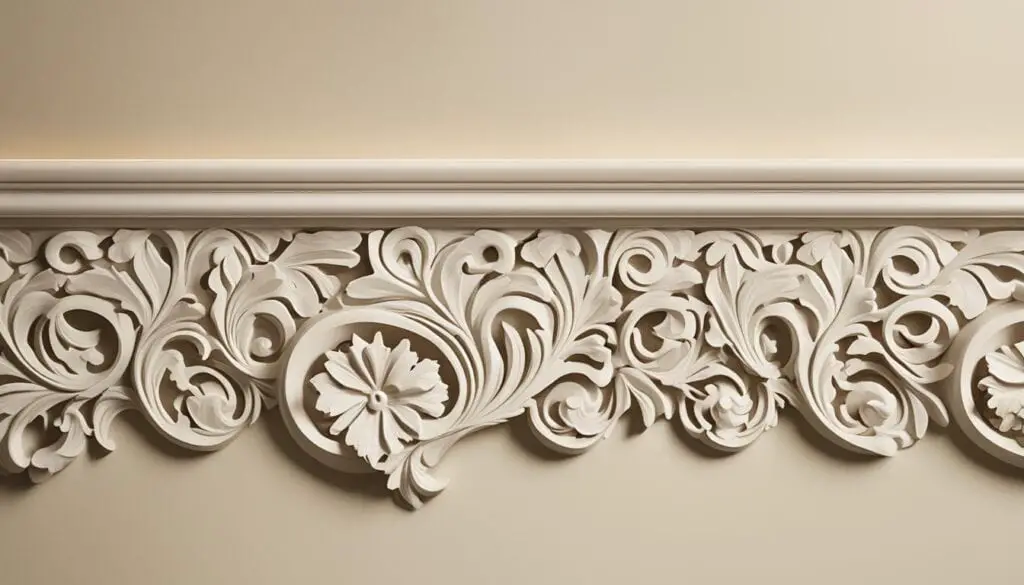
Versatile Applications of Custom Trim and Molding
Custom trim and molding offer endless possibilities for enhancing the aesthetic appeal and overall design of your home. Whether you’re looking to add a touch of elegance or create a cohesive look, custom trim and molding can be applied to various areas, including walls, ceilings, baseboards, windows, doors, fireplace mantels, and crown molding. By incorporating these design elements, you can transform your space into a visually stunning masterpiece.
Let’s explore the versatile applications of custom trim and molding:
1. Walls
Custom trim and molding can be applied to walls to create a sense of depth and visual interest. From simple chair rails to intricate paneling, these additions can elevate the look of any room. Use trim and molding to frame artwork, highlight architectural details, or create visual transitions between walls and ceilings.
2. Ceilings
Add sophistication and elegance to your ceilings with custom trim and molding. From simple crown molding to elaborate ceiling medallions, these details can transform an ordinary ceiling into a stunning focal point. Consider combining different molding profiles to create a unique and eye-catching design.
3. Baseboards
Baseboards not only protect the bottom of your walls from damage but also provide an opportunity to showcase your personal style. Choose from a variety of baseboard profiles, such as sleek and modern or ornate and traditional, to complement your overall design aesthetic.
4. Windows and Doors
Add character and charm to your windows and doors with custom trim and molding. Crown your windows with beautiful casings and frame your doors with elegant trim to create a cohesive look throughout your home. These details can add a touch of sophistication and elevate the overall design.
5. Fireplace Mantels
A fireplace mantel is often the focal point of any living room or family room. Enhance its beauty with custom trim and molding. Whether you prefer a classic and traditional design or a more contemporary and sleek look, there are numerous molding options available that can complement your fireplace mantel perfectly.
6. Crown Molding
Crown molding is the crowning glory of any room. It adds a finishing touch and creates a seamless transition between walls and ceilings. Whether you opt for a simple and clean profile or an intricate and ornate design, crown molding can enhance the elegance and sophistication of your space.
By incorporating custom trim and molding throughout your home, you can create a cohesive and visually appealing design that reflects your personal style. Let your imagination run wild and transform your space into a work of art.
Various Types of Custom Molding to Consider
When it comes to enhancing the look of your modern baseboards, custom molding can make a significant impact. There are several types of molding to consider, each with its own unique characteristics that can elevate the overall aesthetic of your space.
Crown Molding
Crown molding is a classic choice that adds elegance and sophistication to any room. It sits at the junction where the wall meets the ceiling, creating a seamless transition and visually enhancing the height of the space. Crown molding comes in various styles, from simple to intricately detailed designs, allowing you to choose the perfect option for your home.
Chair Rail
Chair rail molding is typically installed at chair-height on walls, serving both a functional and decorative purpose. It provides protection for walls from potential damage caused by chairs, while also adding visual interest and dividing the wall into distinct sections. Chair rail molding can be used to create a traditional or contemporary look, depending on the style and material chosen.
Casing
Casing molding is used to frame doors and windows, giving them a finished and polished appearance. It helps conceal any gaps between the wall and the door/window frame, creating a cohesive and seamless transition. Casing molding comes in various profiles and can be customized to match the style of your home.
Baseboards
Baseboards are an essential element in any home’s design. They help cover the gap between the wall and the floor, protecting the wall from potential damage and providing an aesthetically pleasing finish. Baseboards come in different heights and styles, allowing you to choose the perfect option to complement your baseboard design.
Wainscoting
Wainscoting adds a touch of elegance and visual interest to walls. It typically consists of decorative panels installed on the lower half of the wall, with a chair rail molding separating the upper and lower sections. Wainscoting can create a classic and timeless look, adding texture and depth to your space.
Beadboard
Beadboard is a type of panel molding that features narrow vertical planks with a beaded design. It adds a charming and nostalgic touch to any space, reminiscent of traditional cottage or farmhouse style. Beadboard can be used on walls, ceilings, or even as an accent piece on furniture.
Panel Molding
Panel molding is a decorative molding used to create the illusion of recessed or raised panels on walls or ceilings. It adds architectural detail and visual interest, transforming plain surfaces into works of art. Panel molding can be customized and combined with other molding styles to create unique and eye-catching designs.
Corbel Molding
Corbel molding features decorative brackets or supports that are applied to walls or furniture. It adds a touch of elegance and architectural interest, creating a visually captivating look. Corbel molding can be used to enhance shelves, mantels, or as an accent on columns or walls.
Cove
Cove molding is characterized by its concave shape and is typically used as a transition between walls and ceilings. It adds a soft and subtle touch, creating a smooth transition and visually enhancing the height of the space. Cove molding can be used in various settings, from traditional to contemporary.
Picture Rail Molding
Picture rail molding is a versatile option that not only adds decorative flair but also serves a functional purpose. It is installed horizontally along the walls, allowing you to hang artwork and other decorative items without having to put holes in the wall. Picture rail molding can be used in various room styles, providing flexibility and convenience.
Each type of custom molding mentioned above brings its own unique charm and character to your modern baseboard design. Whether you’re aiming for a timeless elegance or a contemporary flair, the right choice of molding can elevate the overall look and feel of your space.
Best Materials for Trim and Molding
When it comes to choosing the right materials for trim and molding, there are several options to consider. Each material has its own unique qualities and benefits. Here are the best materials commonly used for trim and molding:
Solid Wood
Solid wood is a classic choice for trim and molding. It offers durability, natural beauty, and a sense of luxury. Solid wood can be painted or stained to match your interior design, making it a versatile option that fits various aesthetics. Whether you prefer the timeless elegance of oak or the warmth of cherry, solid wood trim and molding add a touch of sophistication to any room.
Medium Density Fiberboard (MDF)
If you’re looking for a cost-effective alternative to solid wood, medium density fiberboard (MDF) is an excellent choice. Made from compressed wood fibers and resin, MDF is strong, stable, and easy to work with. It can be painted to achieve any desired color, allowing for endless customization. While not as durable as solid wood, MDF is a popular option for trim and molding due to its affordability and versatility.
Polyurethane
Polyurethane trim and molding are lightweight, resistant to moisture and insect damage, and easy to install. This synthetic material is a popular choice for both interior and exterior applications. Polyurethane trim and molding come in a wide range of styles and designs, including intricate patterns and decorative details. It provides a cost-effective way to add visual interest and architectural elements to your home.
PVC
For areas with high humidity, such as bathrooms or outdoor spaces, PVC trim and molding are an ideal option. PVC is moisture-resistant, durable, and low-maintenance. It won’t warp, rot, or split, making it perfect for environments that are prone to moisture damage. PVC trim and molding are available in various styles, allowing you to achieve the desired look while ensuring long-lasting performance.
Metal
If you’re looking to add a modern and industrial touch to your home, metal trim and molding are the way to go. Metal, such as aluminum or stainless steel, offers a sleek and contemporary aesthetic. It is durable, easy to clean, and resistant to corrosion. Metal trim and molding are commonly used in commercial buildings but can also be incorporated into residential spaces to create a bold and unique statement.
| Material | Benefits |
|---|---|
| Solid Wood | – Durability and natural beauty – Versatility in painting or staining – Adds a touch of sophistication |
| Medium Density Fiberboard (MDF) | – Cost-effective alternative to solid wood – Easy to work with – Versatile and customizable |
| Polyurethane | – Lightweight and resistant to moisture – Wide range of styles and designs – Affordable and easy to install |
| PVC | – Moisture-resistant and durable – Perfect for high humidity areas – Low-maintenance |
| Metal | – Modern and industrial aesthetic – Durable and resistant to corrosion – Easy to clean |
When choosing the material for your trim and molding, consider the specific requirements of your space, your budget, and the desired aesthetic. Whether you prefer the timeless elegance of solid wood, the affordability of MDF, the versatility of polyurethane, the moisture resistance of PVC, or the modern look of metal, there’s a material that will meet your needs and elevate the overall aesthetic of your home.
The Magic of Decorative Trim and Molding in Custom Home Design
In custom home design, decorative trim and molding add a touch of elegance and charm to create a modern luxury living space. Collaborating with an interior design team can help you incorporate these design elements seamlessly into your home, combining contemporary aesthetics with traditional design elements.
Decorative trim in custom homes elevates the overall aesthetic, giving your living space a refined and stylish look. It adds an extra layer of sophistication, highlighting the architectural features and creating a sense of grandeur.
By working closely with an experienced interior design team, you can ensure that all custom trim and molding options are carefully curated to match your personalized vision. They will guide you in selecting the right profiles, finishes, and materials to complement your home’s style and create a cohesive design scheme.
Incorporating decorative trim and molding into your custom home design offers several benefits. Not only does it enhance the visual appeal of your space, but it also adds depth and character to the overall atmosphere. The intricate detailing and craftsmanship of decorative trim and molding evoke a sense of luxury and create an upscale ambiance.
With a wide range of options available, you can choose from various styles, such as crown molding, chair rail, casing, and baseboards, to achieve the desired look. Whether you prefer a contemporary, traditional, or transitional aesthetic, decorative trim and molding can be customized to suit your taste and elevate the overall design.
Moreover, collaborating with an interior design team ensures that the decorative trim and molding seamlessly integrate with other design elements in your home, such as furniture, lighting, and wall treatments. This collaboration ensures a cohesive and visually pleasing result, creating a harmonious balance between functionality and aesthetics.
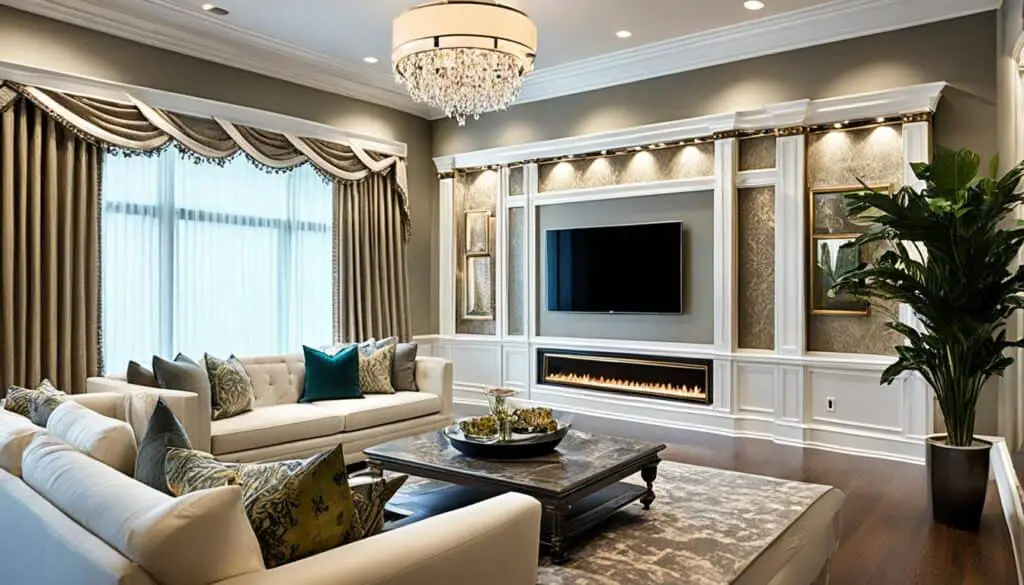
Elegance and Charm
The presence of decorative trim and molding adds an air of elegance and charm to your living space. It creates a sense of sophistication and refinement, making your home stand out from the ordinary. With carefully selected trim and molding, you can transform your house into a luxurious haven that exudes both style and comfort.
Modern Luxury Living Space
The incorporation of decorative trim and molding in custom home design helps in creating a modern luxury living space. It infuses opulence and upscale aesthetics into every corner of your home. The right combination of trim and molding can elevate the ambiance, making your living space feel like a five-star retreat.
Collaboration with Interior Design Team
Working with an interior design team is crucial to achieving the perfect balance of decorative trim and molding in your custom home. Design professionals have an eye for detail, ensuring that every element is thoughtfully considered and expertly executed. Their guidance and expertise can help you create a home that surpasses your expectations and reflects your personal style.
Incorporating Trim and Molding for a Sophisticated Aesthetic
When it comes to creating a sophisticated aesthetic in your custom home construction and design, incorporating trim and molding plays a crucial role. These design elements add elegance, definition, concealment, and value, elevating the overall look and feel of your space. Whether you’re aiming for a timeless and luxurious ambiance or a contemporary and sleek atmosphere, trim and molding offer endless possibilities for enhancing your home’s aesthetic.
Trim and molding contribute to the elegance of a space by defining architectural features and creating a polished finish. The clean lines and intricate details of trim and molding can highlight the unique design elements of your home, bringing out its true character and charm. By carefully selecting the right profiles and materials, you can achieve a sophisticated aesthetic that showcases your personal style and enhances the overall visual appeal.
Another advantage of incorporating trim and molding is their ability to conceal imperfections and transitions between different surfaces. They provide a seamless transition between walls, ceilings, and floors, covering gaps and creating a cohesive look throughout your home. This attention to detail enhances the overall quality and craftsmanship of your custom home, adding value and appeal for potential buyers in the future.
Tables, cabinets, and built-in features can also benefit from the addition of trim and molding. By incorporating these design elements, you can add depth and visual interest to your furniture pieces, elevating their overall elegance and sophistication. Whether it’s a beautifully crafted fireplace mantel or a custom-made bookshelf, trim and molding can take these pieces to the next level, creating a cohesive and visually stunning look in your home.
| Molding Type | Applications |
|---|---|
| Crown Molding | Applied where the walls and ceilings meet, adding a touch of elegance and sophistication. |
| Chair Rail | A horizontal molding installed midway on the wall, protecting it from chair backs and adding visual interest. |
| Casing | Used around doors and windows to create a finished look and define their architectural features. |
| Baseboards | Installed along the bottom of walls to create a transition between the wall and floor, adding a polished finish. |
| Wainscoting | Applied to the lower half of walls to add texture and enhance the overall aesthetic of the room. |
Incorporating trim and molding requires careful planning and attention to detail. Consult with a professional interior designer or custom home builder to determine the best trim and molding options for your space. They can guide you through the selection process, ensuring that the chosen designs and materials align with your vision and complement the overall style of your home.
Key Takeaways:
- Trim and molding contribute to a sophisticated aesthetic in custom home construction and design.
- They add elegance, definition, concealment, and value to your space.
- Trim and molding can define architectural features and create a polished finish.
- They can also conceal imperfections and transitions between surfaces.
- Tables, cabinets, and built-in features can benefit from the addition of trim and molding.
Customization and Creativity with Decorative Trim and Molding
When it comes to home decor, customization and creativity are key to creating a space that truly reflects your personal style. And one area where you can let your imagination run wild is in the design and installation of decorative trim and molding. By mixing and matching molding styles, you can create unique room designs that showcase your individuality and add richness to your home decor.
The beauty of decorative trim and molding is that it can be customized to suit any room or design theme. Whether you prefer a more traditional look or a sleek, modern aesthetic, there are endless options to choose from. By incorporating different molding profiles, sizes, and finishes, you can create a truly bespoke look that sets your home apart.
One way to unleash your creativity is by combining different molding styles within the same space. For example, you can pair a clean and contemporary baseboard molding with a more ornate crown molding to create a visually striking contrast. This mixing and matching of styles adds visual interest and depth to your room, making it stand out with its unique charm.
Unique Room Designs
By experimenting with different molding styles, you can transform ordinary rooms into extraordinary spaces. Think outside the box and consider unconventional applications for trim and molding. For instance, you can use panel molding to create elegant and eye-catching accent walls, or install chair rail molding to break up the height of a tall room and add architectural interest.
Additionally, you can use trim and molding to bring attention to specific areas of your room. For example, framing a beautiful piece of artwork or a statement mirror with decorative molding can elevate its impact and make it the focal point of the space. These unique room designs not only showcase your personal style, but they also create a sense of luxury and sophistication.
Richness in Home Decor
The incorporation of decorative trim and molding brings a touch of elegance and richness to your home decor. It adds dimension and texture to your walls, making them visually appealing and inviting. The intricate details and craftsmanship of the molding create a sense of luxury, even in the most modest of spaces.
When it comes to choosing the right molding styles for your home, consider the overall design theme and aesthetic you want to achieve. If you’re going for a more traditional look, opt for crown molding with classic details and intricate patterns. For a modern and minimalist vibe, choose clean and sleek profiles that add subtle sophistication.
No matter which molding styles you choose, it’s important to select high-quality materials that will withstand the test of time. Solid wood moldings offer durability and a timeless appeal, while synthetic options like polyurethane provide a cost-effective and low-maintenance alternative.
| Molding Style | Description |
|---|---|
| Crown Molding | Adds elegance and grandeur to a room with its decorative design. |
| Baseboard Molding | Creates a transition between the wall and floor, enhancing the overall aesthetic. |
| Chair Rail Molding | Protects walls from damage while adding a touch of sophistication. |
| Panel Molding | Creates visual interest by adding depth and texture to plain walls. |
| Picture Rail Molding | Allows for the easy hanging and rearranging of artwork or photographs. |
As you explore the world of decorative trim and molding, remember that the possibilities are virtually endless. Let your creativity soar and experiment with different styles, materials, and combinations to achieve the perfect look for your home. Whether you prefer a classic, timeless design or a more contemporary aesthetic, mixing and matching molding styles is the key to creating unique room designs and adding that extra touch of richness to your home decor.
Stay on Trend with Modern Trim and Molding Styles
When it comes to modern home design, it’s essential to stay on trend with the latest trim and molding styles. These design elements not only enhance the aesthetics of your space but also add a touch of timeless elegance. To help you choose the right trim for your home, here are some popular options:
Craftsman Trim
Craftsman trim features clean lines and a minimalist design, making it perfect for modern and contemporary spaces. Its simplicity adds a touch of sophistication while maintaining a sleek and uncluttered look.
Colonial Trim
Colonial trim is known for its intricate patterns and detailed craftsmanship. It brings a sense of traditional elegance to any room and works well in classic or vintage-inspired interiors.
Victorian Trim
For a more ornate and opulent look, Victorian trim is an excellent choice. It showcases elaborate details and decorative motifs, adding a touch of grandeur to your space.
Contemporary Trim
If you prefer a clean and minimalist aesthetic, contemporary trim is the way to go. It features sleek lines and a streamlined design, providing a modern and polished look to your home.
Rustic Trim
Rustic trim brings a cozy and warm feel to your home. With its distressed finish and natural textures, it adds character and charm to any space, creating a rustic and inviting atmosphere.
Farmhouse Trim
Combining modern and rustic elements, farmhouse trim is a popular choice for those seeking a blend of traditional and contemporary styles. It adds a touch of farmhouse charm to your home, creating a cozy and welcoming ambiance.
By incorporating these trending molding designs, such as craftsman trim, colonial trim, victorian trim, contemporary trim, rustic trim, and farmhouse trim, you can elevate the overall aesthetic of your home and stay on top of the latest design trends.
Now that you’re familiar with the trending trim and molding styles, it’s time to explore how decorative trim and molding can transform your home’s look and feel.
Conclusion
Elevate the look of your home with modern baseboard styles and the incorporation of decorative trim and molding. Personalized home design allows you to create a unique and sophisticated aesthetic that reflects your style and elevates the overall aesthetic of your home. By selecting contemporary baseboard ideas and staying up-to-date with the latest baseboard trends, you can add a stylish touch to your walls and enhance the visual depth of your rooms.
Choosing the right material for your baseboards is essential in achieving both durability and aesthetics. Whether you opt for wood baseboards for their timeless beauty, medium density fiberboard (MDF) for its cost-effectiveness, or plastic or PVC baseboards for their moisture-resistance, each material offers its advantages. Consider the height and style of your baseboards, such as applied, flush, or floating baseboards, and explore different baseboard moulding styles to find the perfect fit for your home.
Don’t stop at just baseboards – explore the benefits of adding decorative trim and molding throughout your home. These design elements bring elegance, definition, and value to your space, concealing imperfections and enhancing the overall architectural appeal. From walls and ceilings to windows, doors, and fireplace mantels, custom trim and molding can be applied in various versatile ways, creating a cohesive and visually appealing design. Consider different types of custom molding such as crown molding, chair rail, casing, wainscoting, and picture rail molding to add sophisticated touches to your personalized home design.
Incorporating trim and molding into your custom home design requires thoughtful consideration. Working with an interior design team can help you achieve a seamless collaboration of contemporary aesthetics and traditional design elements, resulting in a modern luxury living space. By mixing and matching molding styles and staying on-trend with modern trim styles like craftsman, colonial, victorian, contemporary, rustic, or farmhouse trim, you can add richness and depth to your home decor and create a truly personalized and elevated home aesthetic.
FAQ
Why are baseboards important in home design?
Baseboards add visual depth to rooms, protect fragile finishes, and cover gaps between walls and floors.
What are the different materials for baseboards?
You can choose from options like wood, medium density fiberboard (MDF), and plastic or PVC.
How do I select the height and style of baseboards?
Baseboard height is a personal preference, and there are styles like applied, flush, and floating baseboards to choose from.
Can I enhance baseboards with additional moulding?
Yes! You can add base shoe moulding or quarter round moulding to enhance the look of your baseboards.
What are the top modern baseboard styles for 2023?
The trending styles include craftsman trim, colonial trim, victorian trim, contemporary trim, rustic trim, and farmhouse trim.
What are the benefits of adding decorative trim and molding to my home?
Decorative trim and molding add elegance, definition, conceal imperfections, and increase the value of your property.
Where can I use custom trim and molding in my home?
You can apply custom trim and molding to walls, ceilings, baseboards, windows, doors, fireplace mantels, and crown molding.
What are the various types of custom molding to consider?
Some options include crown molding, chair rail, casing, baseboards, wainscoting, beadboard, panel molding, corbel molding, cove, and picture rail molding.
What materials can trim and molding be made from?
Trim and molding can be made from solid wood, medium density fiberboard (MDF), polyurethane, PVC, and metal.
How can decorative trim and molding enhance custom home design?
Decorative trim and molding add elegance and charm, creating a modern luxury living space when collaborated with an interior design team.
What is the importance of trim and molding in custom home construction and design?
Trim and molding contribute to a sophisticated aesthetic, adding elegance, defining architectural features, concealing imperfections, and increasing the value of a custom home.
How can I achieve customization and creativity with decorative trim and molding?
You can mix and match molding styles to create unique room designs, adding richness and depth to your home decor.
What are the popular modern trim and molding styles to stay on trend?
The trending styles include craftsman trim, colonial trim, victorian trim, contemporary trim, rustic trim, and farmhouse trim, adding timeless elegance to your home.
How can modern baseboard styles and decorative trim and molding elevate my home’s look?
Incorporating modern baseboard styles, along with personalized decorative trim and molding, allows you to create a unique and sophisticated aesthetic that elevates the overall look of your home.

